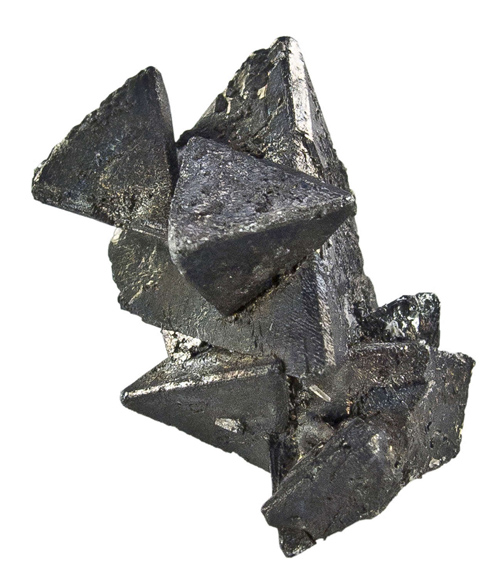The Mineral tennantite

Tennantite is the arsenic-rich
end member of the
Tetrahedrite series. Tennantite is the less common member of this series, and is sometimes indistinguishable from Tetrahedrite by common methods. Tennantite was named in 1819 in honor of English chemist Smithson Tennant (1761-1815), who was best known for his discovery of the rare elements iridium and osmium, as well as proving the identity of
Diamond and
Graphite from the
element carbon.
Chemical Formula
Cu12As4S13
Color
Steel Gray to black. May also be iridescent with a colorful metallic film, or may have a dull gray film.
Properties
Streak
Reddish-brown, dark gray, black |
Hardness
3 - 4 |
Transparency
Opaque |
Specific Gravity
4.6 - 4.8 |
Luster
Metallic |
Cleavage
None |
Fracture
Subconchoidal |
Tenacity
Brittle |
Crystal Habits
In tetrahedral crystals and stacked clusters, resembling triangular pyramids. Also in complex, rounded crystals with many crystal faces, formed from a combination of cubic-tetrahedral crystals. Commonly grainy and massive. Crystals may be deeply striated in a triangular pattern, and may also be intergrown.
Additional Information
Composition
Copper arsenic sulfide, with some antimony replacing the arsenic. Iron and zinc variably substitute the copper up to 15 percent. |
In Group
Sulfides; Sulfosalts |
Striking Features
Crystal structure, mode of occurrence, and lack of cleavage |
Environment
In low to moderate grade hydrothermal and epithermal vein deposits, and in contact metamorphic deposits. |
Rock Type
Sedimentary, Metamorphic |
Other Names

|
Fahlerz
|
Old German term for Tetrahedrite, describing it as ashen-colored ore. The name is in reference to its lack of yellow or copper hue and application as a copper ore. |

|
Julianite
|
|
Varieties
-
Bismuth-rich variety of Tennantite (and occasionally Tetrahedrite as well.) Discredited as an independent mineral by the IMA in 2008.
-
Silver-rich form of Tennantite with silver in place of much of the copper. Argentotennantite is technically not a variety of Tennantite, but rather classified as an independent mineral by the IMA.
-
Variety of Tennantite from the Lengenbach Quarry in the Binn valley of Switzerland, noted for its rounded shape and many crystal faces.
Uses
Tennantite is an ore of copper. Silver may also be present in its structure at certain localities, where it may also be used as an ore of silver.
Noteworthy Localities
Tennantite crystals in unique, equidimensional crystals with multiple crystal faces are found at the Lengenbach Quarry, Binn Valley, Wallis, Switzerland, where they are known as Binnite. Good crystals, often integrown together Pyrite, have come from Cavnic (Kapnic), Maramureș Co., Romania. Some of the largest and best-formed Tennantite crystals have come from the Tsumeb, Otjikoto, Namibia. This locality has also produced highly prized Tennantite pseudomorphs after Azurite. Good Tennantite crystal clusters have recently been coming from the Dzhezkazgan Mine, Karagandy Province, Kazakhstan.
Lustrous crystals of Tennantite have come from several of the
ore deposits in Peru, especially at the Julcani Mine, Huancavelica Department; and the Quiruvilca Mine, La Libertad Department. In Mexico, sharp crystals on contrasting white
Quartz are well-known from the Cobre Mine, Concepción del Oro, Zacatecas. In the U.S., triangular crystal clusters of Tennantite have come from the Butte District, Silver Bow Co., Montana, especially at the Leonard Mine.
Distingushing Similar Minerals
Tetrahedrite - Very difficult to distinguish without complex tests, although certain localities are indicative of Tetrahedrite.
Enargite - Different crystal habits.